NCERT Solutions for Class 12 Macro Economics Government Budget and the Economy
Class 12 Economics textbook solutions Chapter-8 Government Budget and the Economy will give students an advantage with practical questions. NCERT Solutions provided are easy to understand and each step in the solution is described to match student understanding. Study it CBSE Class 12 Economics NCERT Solutions are curated by subject experts and students can rely on these to score well. NCERT Solutions Economics is prepared as per the latest CBSE Syllabus of www.studyit.in and you can use them during your homework or for your preparation.
Do you want to score high marks in economics in class 12 CBSE board Exams? Then following NCERT Solutions for Class 12 Economics free PDF can help you do it
NCERT Solutions for Class 12 Economics guides you through this with utmost precision by offering you easy access to important topics in every chapter – so that you save valuable time right before the exam.
NCERT TEXTBOOK QUESTIONS SOLVED
Question 1. Explain why public goods must be provided by the government? [3-4 Marks]
Answer:
- Public goods are those goods and services for which consumption by some individuals does not reduce the amount available to others.
- For example parks,roads,water,bridges,national defense etc..
- these goods are non-rival and non-excludable ones.
- people receives benefits from public goods but do not pay for them.Such a goods can only prepared by government.
Question 2. Distinguish between revenvu expenditure and capital expenditure .
State the basis of classifying government expenditure into revenue and capital expenditure. Give an example of each.
Answer: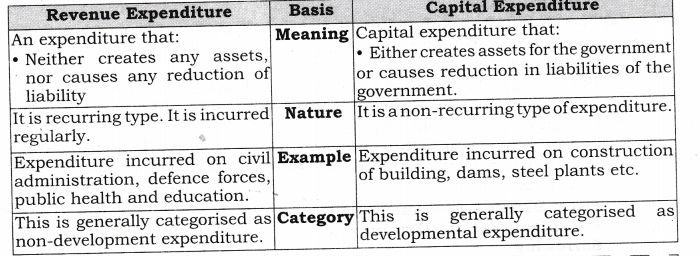
Question 3. The fiscal deficit gives the borrowing requirement of the government Elucidate. [3-4 Marks]
Answer:
- Fiscal deficit is defined as excess of total expenditure over total receipts (revenue and capital receipts) excluding borrowing. In the form of an equation:
Fiscal Deficit = Total Budget Expenditure – Total Budget Receipts (Net of borrowing)
= Total Expenditure (Revenue
Expenditure + Capital Expenditure) – Revenue Receipts (Tax Revenue + Non-Tax Revenue) – Non-Debt Capital Receipts (Recovery of Loans + Dis-investment Proceeds)
= Revenue Deficit + Capital Deficit (excluding Borrowing)- Borrowing
= Net borrowing at home + Borrowing from RBI + Borrowing from abroad - Fiscal deficit shows total borrowing requirements of the government from all sources.
- As the government borrowing increases, its liability in future to repay loan with interest also increases leading to a higher revenue deficit. Therefore, fiscal deficit should be as low as possible.
Question 4. Give the relationship between revenue deficit and fiscal deficit. [3-4 Marks]
Answer:
- Fiscal deficit is always a wider concept than revenue deficit.
- Revenue deficit is defined as the excess of government’s revenue expenditure over revenue receipts. In terms of formula:
Revenue Deficit = Revenue Expenditures (RE) – Revenue Receipts (RR) - In short, there will be revenue deficit in a government budget when revenue expenditure exceeds revenue receipts.
- Fiscal deficit is defined as the excess for all expenditure over total receipts net of borrowings.
- Initially, Fiscal deficit does not take into account all types of receipts. It does not take into account borrowings. But finally they have to depend on borrowing to met fiscal deficit.
Fiscal Deficit = Revenue Deficit + Capital Deficit (Excluding Borrowing)- Borrowing
= Net borrowing at home + Borrowing from RBI + Borrowing from abroad
Question 5. Does public (government) debt impose a burden? Explain. [3-4 Marks]
Answer: Public debt is not always a blessing. Excessive use of it creates a lot of crisis in an economy; such as,
- Hampers Economic Development of a Country: Loans are easily borrowed but it is very difficult to repay them.Generally, government imposes more taxes. It brings instability and is an obstacle in the economic development of a country.
- Poses Threat to Political Freedom: Foreign loans and assistance lead to deep conflict among countries. The friction among countries challenges the political freedom.
- Proves a Burden on Common Man: Loans taken for unproductive purposes, like war and armaments, are a burden on common man in the form of higher taxes.
- Leads to Extravagant Spending: Public debt leads to unplanned spending. This provides incentive to the government to implement the schemes that require excessive expenditure.
- Results in Drain of National Wealth: Repayment of foreign loans results in drain of wealth out of the country.
Question 6. Are fiscal deficits necessarily inflationary? [3-4 Marks]
Or
“Governments across nations are too much worried about the term fiscal deficit”. Do you think that fiscal deficit is necessarily inflationary in nature? Support your answer with valid reasons.
Answer:
- Fiscal deficits are not necessarily inflationary.
- As we know fiscal deficit shows borrowing requirement of the government.
- If we borrow when there is a situation of underemployment in an economy i.e., in a situation of deficient demand, then it is not inflationary because in a situation of deficient demand output is held back because of lack of demand.
- A high fiscal deficit (borrowing) is accompanied by higher demand and greater output which is not inflationary.
- On the other hand, if we borrow at the full employment level, then it is inflationary in nature.
- A high fiscal deficit (borrowing) is accompanied by higher prices because aggregate demand is greater than aggregate supply at the full employment level which is always inflationary.
Question 7. Discuss the issue of deficit reduction.[3-4 Marks]
Answer: The deficit in a government budget can be reduced by the following steps:
- Taxes should be increased. Government can make a plan for rising direct taxes to increase its receipts can also be raised by increasing rates of taxes or by imposing new taxes.
- Reduction in Government Expenditures: It can be done through making government activities more efficient through better planning of programmes and better administration.
- The government can raise Receipts through the sale of shares in PSUs (Public Sector Undertaking).
- Changing the scope and role of government by withdrawing from same areas where it operated before.
MORE QUESTIONS SOLVED
I. Very Short Answer Type Questions (1 Mark)
Question 1. Define government budget.
Answer: A government budget is an annual financial statement showing item wise estimates of expected revenue and anticipated expenditure during a fiscal year.
Question 2. State any one obj ective of a government budget.
Answer: Activities to secure a reallocation of resources
Question 3. Define a tax.
Answer: A tax is a legally compulsory payment imposed by the government on income and profit of persons and companies without reference to any benefit. Tax is of two types: Direct tax and Indirect tax.
Question 4. Why is service tax an indirect tax?
Answer: Its impact and incidence lie on different persons.
Question 5. State any two sources of non-tax revenue receipts.
Answer:
- Commercial revenue (profit and interest)
- Administrative revenueffees, fines and penalties, escheats etc)
Question 6. Is borrowing by the government a revenue receipt?
Answer: No, it is not so because it creates a liability (for the government) of repayment.
Question 7. Why is tax not a capital receipt?
Answer: Tax is not a capital receipt because it leads neither to creation of liability nor to reduction in assets.
Question 8. Why is interest termed as a revenue receipt?
Answer: Interest is a revenue receipt because it creates neither any liability nor causes a reduction in the assets of the government.
Question 9. Why are borrowings a capital receipt?
Answer: They create a liability (in terms of repayment).
Question 10. Why are subsidies treated as revenue expenditure?
Answer: Subsidies are treated as revenue expenditure because they create neither any asset nor cause a reduction in any liability of the government.
Question 11. Why is repayment of loan a capital expenditure?
Answer: It reduces the liabilities of the government.
Question 12. Why is recovery of loans treated as a capital receipt?[CBSE All India 2005]
Answer: Recovery of loans is treated as a capital receipt because it reduces assets of the government.
Question 13. Why are receipts from taxes categorised as revenue receipts?
Answer: Receipts from taxes are categorised as revenue receipts because they create neither any liability nor cause a reduction in the assets of the government.
Question 14. What is meant by revenue deficit?
Answer: Revenue deficit refers to the excess of revenue expenditure of the government over its revenue receipts. Revenue Deficit = Revenue Expenditure- Revenue Receipts
Question 15. If the revenue receipts are Rs. 1,000 crore and revenue expenditure is Rs. 1,200 crore, how much will be the revenue deficit?
Answer: Revenue Deficit = Revenue Expenditure – Revenue Receipts = 1,200 – 1,000 = Rs. 200 crore.
Question 16. Define fiscal deficit.
Answer: Fiscal deficit is defined as excess of total expenditure over total receipts (revenue and capital receipts) excluding borrowing.
Question 17. What is the meaning of primary deficit?
Answer: Primary deficit refers to the difference between fiscal deficit of the current year and interest payments on the previous borrowings.
Question 18. How is primary deficit calculated?
Answer: Primary Deficit = Fiscal Deficit – Interest Payments
Question 19. What does zero primary deficit mean?
Answer: If primary deficit is zero, fiscal deficit= interest payments. It means the government has to borrow only for its interest commitments on earlier loans.
II. Multiple Choice Questions (1 Mark)
Question 1. Budget is placed before:
(a) Lok Sabha
(b) Rajya Sabha
(c) Both Lok Sabha and Rajya Sabha
(d) Parliament
Answer: (c)
Question 2. Budget is a:
(a) Financial statement
(b) Monetary statement
(c) Political statement
(d) All of them
Answer: (a)
Question 3. Which article of the Constitution takes about the budget?
(a) Article 110 (b) Article 111
(c) Article 112 (d) Article 113
Answer: (c)
Question 4. One year period from 1 April to 31 March of next year is called a:
(a) Monetary year (b) Fiscal year
(c) Plan year (d) Tax year
Answer: (b)
Question 5. Capital receipts may come from:
(a) Market borrowings
(b) Provident funds
(c) Recoveries of loans
(d) All of them
Answer: (d)
Question 6. Find direct tax among the following taxes:
(a) Personal income tax
(b) Excise duty
(c) Sales tax
(d) Service tax
Answer: (a)
Question 7. Among the following types of taxes, find the indirect one.
(a) Gift tax
(b) Corporate income tax
(c) VAT
(d) Wealth tax
Answer: (c)
Question 8. If budgetary deficit is nil and borrowings and other liabilities are 70 crore, what is the amount of fiscal deficit?
(a) Nil (b) 30 crore
(c) Can’t say (d) 70 crore
Answer: (d)
Question 9. When the government tries to,meet the gap of public expenditure and public revenue through borrowing from the banking system, it is called
(a) deficit financing
(b) debt financing
(c) credit financing
(d) none of them
Answer: (a)
Question 10. ……….is the difference between
total receipts and total expenditure.
(a) Fiscal deficit
(b) Budget deficit
(c) Revenue deficit
(d) Capital deficit
Answer: (b)
Question 11. If borrowings and other liabilities are added to the budget deficit, we get
(a) revenue deficit
(b) capital deficit
(c) primary deficit
(d) fiscal deficit
Answer: (d)
Question 12. Payment of interest is _
(a) revenue expenditure.
(b) capital expenditure
(c) primary deficit.
(d) fiscal deficit
Answer: (a)
Question 13. If the total receipts are Rs.1000 crore and total expenditure is ?1500 crore, how much will be the budgetary deficit?
(a) 500 crore (b) 1500 crore
(c) 1000 crore (d) -500 crore
Answer: (a)
Question 14. A government shows a primary deficit of ?4400 crore. The revenue expenditure on interest payment is Rs.400
crore. How much is the fiscal deficit?
(a) 4000 crore (b) 4800 crore
(c) 4400 crore (d) -400 crore
Answer: (b)
Question 15. A government shows a primary deficit of Rs 10,000 crore. The revenue expenditure on interest payment is Rs 8000 crore. How much is the fiscal deficit?
(a) 18000 crore (b) 10000 crore
(c) 8000 crore (d)-8000 crore
Answer: (a)
Question 16. In a government budget, revenue deficit is Rs,50,000 crore and borrowings are Rs.75,000 crore. How much is the fiscal deficit?
(a) 50000 crore (b) 75000 crore (c) 25000 crore (d) -25000 crore
Answer: (b)
Question 17. Borrowing in government budget is: (Choose the correct alternative)[CBSE 2015]
(a) Revenue deficit
(b) Fiscal deficit
(c) Primary deficit
(d) Deficit in taxes
Answer: (b)
Question 18. The non – tax revenue in the following is: (Choose the correct alternative
(a) Export duty (b) Import duty (c) Dividends (d) Excise
Answer: (c)
Question 19. Primary deficit in a government budget is: (Choose the correct alternative)
(a) Revenue expenditure – Revenue receipts
(b) Total expenditure – Total receipts
(c) Revenue deficit – Interest payments
(d) Fiscal deficit – Interest payments
Answer: (d)
Question 20. Direct tax is called direct because it is collected directly from: (Choose the correct alternative)
(a) The producers on goods produced
(b) The sellers on goods sold
(c) The buyers of goods
(d) The income earners
Answer: (d)
Question 21. The government budget has a revenue deficit. This gets financed by:
(A) Borrowing
(B) Disinvestment
(C) Tax revenue
(D) Indirect taxes
(a) A and D (b) C and D
(c) A and B (d) C and D
Answer: (c)
Question 22. Which of the following statement is not true for fiscal deficit?
A fiscal deficit:
(a) represents the borrowing of the government.
(b) is the difference between total expenditure and total receipts of the government.
(c) is the difference between total expenditure and total receipts other than borrowing.
(d) increases the future liability of the government
Answer: (b)
Question 23. The government budget of a hypothetical economy presents the following information, which of the following value represents Budgetary Deficit, (all fig. in ? crores)
1. Revenue Expenditure = 25,000
2. Capital Receipts = 30,000
3. Capital Expenditure = 35,000
4. Revenue Receipts = 20,000
5. Interest Payments = 10,000
6. Borrowings = 20,000
(a) Rs. 12,000
(b) Rs. 10,000
(c) Rs. 20,000
(d) None of the above.
Answer: (b)
Question 24. Which of the following statement is true?
(a) Loans from IMF is a Revenue Receipt.
(b) Higher revenue deficit necessarily leads to higher fiscal deficit.
(c) Borrowing by a government represents a situation of fiscal deficit.
(d) Revenue deficit is the excess of capital receipts over the revenue receipts.
Answer: (c)
III. Short Answer Type Questions (3-4 Marks)
Question 1. Explain objective of stability of prices of government budget. [CBSE, (F) 2010] Or
Explain the ‘economic stability’ objective of a government budget. [CBSE, AI2011] Or
Explain stabilising activities function of budget.
Answer:
- Free play of market forces (or the forces of supply and demand) are bound to generate trade cycles, also called business cycles.
- These refer to the phases of recession, depression, recovery and boom in the economy.
- The government of a country is always committed to save the economy from business cycles. Budget is used as an important policy instrument to combat(solve) the situations of deflation and inflation.
- By doing it the government tries to achieve the state of economic stability.
- Economic stability leads to more investment and increases the rate of growth and development.
Question 2. Name two sources each of non-tax revenue receipts. [CBSE 2004]
Answer: Non-tax revenue refers to government revenue from all sources other than taxes called non-tax revenue. These are incomes, which the government gets by way of sale of goods and services rendered by different government departments. Its two sources are:
- Commercial Revenue (Profit and interest): It is the revenue received by the government by selling the goods and services produced by the government agencies. For example, profit of public sector undertakings like Railways, BHEL, LIC etc. Government gives loan to State Government, union territories, private enterprises and to general public and earns interest receipts from these loans. It also includes interest and dividends on investments made by the government.
- Administrative Revenue: The revenue that arises on account of the administrative function of the government. This includes:
(i) Fee: Fee refers to a payment made to the government for the services that it renders to the citizens. Such services are generally in public interest and fees are paid by those, who receive such services. For example, passport fees, court fees, school fees in government schools,
(ii) License Fee: License fee is a payment to grant a permission by a government authority. For example, registration fee for an automobile.
Question 3. Distinguish between: Revenue receipts and capital receipts. [CBSE 2005, 10]
Or
Distinguish between ‘revenue receipt’ and ‘capital receipt’ and give two examples of each. [CBSE 2007]
Answer:

Question 4. Distinguish between Direct tax and indirect tax.
Answer: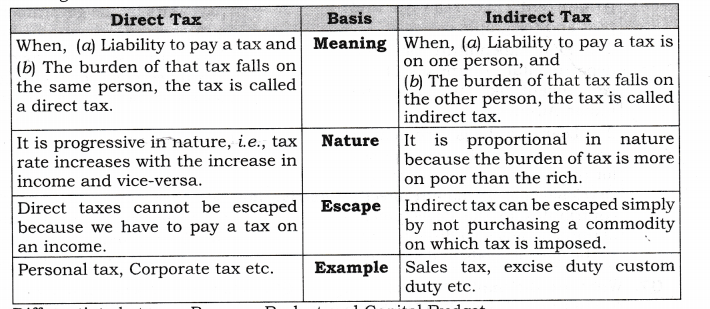
Question 5. Differentiate between Revenue Budget and Capital Budget.
Answer: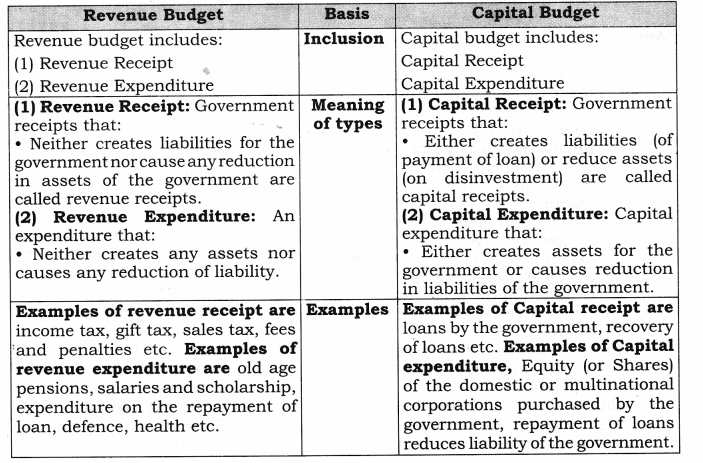
Question 6. Differentiate between Developmental and Non-Developmental Expenditure.
Answer: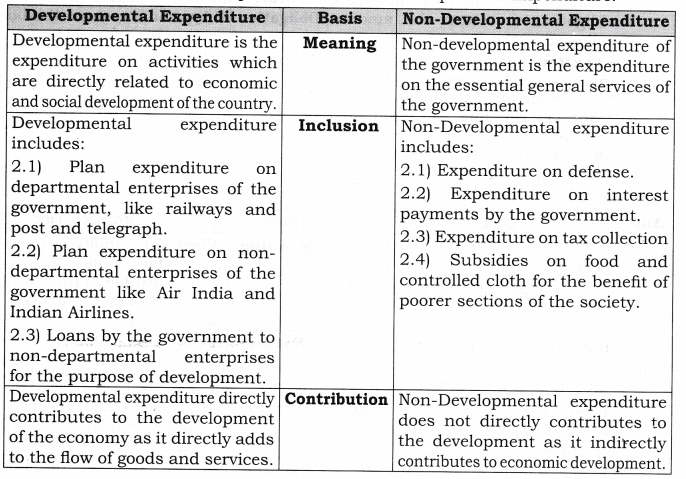
Question 7. What are the implications of a large revenue deficit? Give two measures to reduce this deficit. [CBSE Sample Paper 2010]
Answer:
- Revenue deficit indicates dis¬savings on government account because the government has to make up uncovered gap.
- Revenue deficit implies that the government has to cover’this uncovered gap by drawing upon capital receipts either through borrowing or through sale of its assets.
- Since government is using capital receipts to meet generally consumption expenditure of the government which leads to an inflationary situation in the economy.
Two measures to reduced revenue deficit are :
- Government should reduce its unproductive or unnecessary expenditure.
- Government should increase its receipts from various sources of tax and non-tax revenue.
Question 8. What are implications of fiscal deficit? [A/2005; CBSE 06C, 07]
Answer:
- Causes Inflation: An important component of government borrowing includes borrowing from the Reserve Bank of India. This invariably implies deficit financing or meeting deficit requirements of the government by way of printing more notes. This is a dangerous practice, though very convenient for the government. It increases circulation of money and causes inflation.
- Increase in Foreign Dependence:Government also borrows from rest of the world. It increases our dependence on other countries. Foreign borrowing is often associated with economic and political interference by the lender countries. It increases our economic slavery.
- Financial Burden for Future Generation: Borrowing implies accumulation of financial burdens for the future generations. It is for future generations to repay loans as well as the mounting interest thereon.
- Deficits Multiply Borrowings:Payments of interest increases revenue expenditure of the government, causing an increase in its revenue deficit. Thus, a vicious circle set wherein deficits multiply borrowings.
IV. True Or False
Are the following statements true or false? Give reasons.
Question 1. Government budget is a statement of actual receipts and payments of the government.
Answer: False.
Reason: It is a statement of “Estimated’ (and not actual) receipts and payments of the government.
Question 2. Rise in revenue deficit will always lead to higher fiscal deficit.
Answer: False.
Reason: Fiscal deficit leads to rise in revenue deficit.
Question 3. Service tax is a indirect tax as its impact and incidence is on the same individual.
Answer: False.
Reason: Its burden can be shifted to others.
Question 4. Direct tax are generally ‘Proportional’ in nature.
Answer: False.
Reason: Direct taxes are generally ‘progressive’ in nature.
Question 5. Primary deficit is the difference between capital deficit and interest payments.
Answer: False.
Reason: Primary deficit is the difference between fiscal deficit and interest payments.
Question 6. Non-debt capital receipts only includes disinvestment.
Answer: False.
Reason: It also includes the recovery of loan.
Question 7. Fiscal deficit is non-inflationary.
Answer: False.
Reason: Fiscal deficit can be inflationaiy when we are at full employment level.
It is so because large fiscal deficits creates excess money supply that creates inflation.
Question 8. Expenditure made on the development of a railway line is a capital expenditure.
Answer: True.
Reason: This expenditure creates an asset for the railway and government.
Note: As per CBSE guidelines, no marks will be given if reason to the answer is not explained.
Note: As per CBSE guidelines, no marks will be given if reason to the answer is not explained.
V. Long Answer Type Questions (6 Marks)
Question 1 .
Explain the role the government can play through the budget in influencing allocation of resources. [CBSE 2015] OR .
Explain the ‘allocation of resources’ objective of government budget.[CBSE 2011] OR
Explain the allocation function of agovernment budget. [CBSE AI2010]OR
Explain how government can influence allocation of resources through government budget.
Answer:
- Private enterprises always desire to allocate resources to those areas of production where profits are high.
- However, it is possible that such areas of production (like production of alcohol) may not promote social welfare.
- Through its budgetary policy the government of a country directs ‘ the allocation of resources in a manner such that there is a balance between the goals of profit maximisation and social welfare.
- Production of goods which are injurious to health (like cigarettes and whisky) is discouraged through heavy taxation.
- On the other hand, production of “socially useful goods” (like electricity, ‘Khadij is encouraged through subsidies.
- So, finally government has to reallocate resources in accordance to social and economic considerations in case the free market fails to do or does so inefficiently.
Question 2. Explain how the government can use the budgetary policy in reducing inequalities of incomes. [AI 2015] OR
How can a government budget help in reducing inequalities of income? Explain. [CBSE 2009]OR
How can a government budget be helpful in altering distribution of income in an economy? Explain.[CBSE 2010] OR
Explain ‘redistribution of income’ objective of government budget. [CBSE2011, A/2011] OR
Reduction in income inequalities raises welfare of the people. How can government help, through government budget, in this regard? Explain? [A/2013, C (Set /)]
Answer:
- Budget of a government shows its comprehensive exercise on the taxation and subsidies.
- A government uses fiscal instruments of taxation and subsidies with a view of improving the distribution of income and wealth in the economy.
- A government reduces the inequality in the distribution of income and wealth by imposing taxes on the rich and giving subsidies to the poor, or spending more on welfare of the poor.
- It will reduce income of the rich and raises the living standard of the poor, thus, leads to equitable distribution of income.
- Expenditure on special anti poverty and employment schemes will be increased to bring more people above poverty line.
- Public distribution system should be inferred so that only the poor could get foodgrains and other essential items at subsidised prices.
- Equitable distribution of income and wealth is a sign of social justice which is as the principal objective of any welfare state in India.
Categorize the following items into Revenue and Capital Receipts
Question 1. Statement—Loan from the Australian government. [CBSE Delhi 2006]
Answer: Capital receipt.
Reason: It creates liability for the government.
Question 2. Statement—Corporation tax. [CBSE Delhi 2006, Sample Paper 10] OR
Statement—Income tax received by government.
Answer: Revenue receipt.
Reason: It creates neither any liability nor reduces any asset of the government.
Question 3. Statement—Grants received from International Monetary Fund
Answer: Revenue receipt.
Reason: It creates neither any liability nor reduces any asset of the government.
Question 4. Statement—Profits of public sector undertakings. [ CBSE Sample Paper 2010]
Answer: Revenue receipt.
Reason: It creates neither any liability nor reduces any asset of the government.
Question 5. Statement—Sale of a public sector undertaking. [CBSE Delhi 2006]OR
Statement—Receipts from sale of shares of a public sector undertaking. [CBSE Sample Paper 2010]
Answer: Capital receipt.
Reason: It reduces assets of the government.
Question 6. Statement—Foreign aid against earthquake victims.
Answer: Revenue receipt.
Reason: It creates neither any liability nor reduces any asset of the government.
Question 7. Statement—Dividends on investments made by government.[CBSE Delhi 2006]
Answer: Revenue receipt.
Reason: It creates neither any liability nor reduces any asset of the government.
Question 8. Statement—Borrowings from public.
Answer: Capital receipt.
Reason: It creates liability for the government.
Question 9. Statement—Fees of a Government College.
Answer: Revenue receipt.
Reason: It creates neither any liability nor reduces any asset of the government.
Question 10. Statement—Recovery of loans. [CBSE Delhi 2006]
Answer: Capital receipt.
Reason: It reduces assets of the government.
Question 11. Statement—Loans recovered from public sector enterprises.
Answer: Capital receipt.
Reason: It reduces assets of the government.
Question 12. Statement—License and court fees received by the government in the year 2012-13
Answer: Revenue receipt.
Reason: It creates neither any liability nor reduces any asset of the government.
Question 13. Statement—Loan taken from the USA for the infrastructural developments.
Answer: Capital receipt.
Reason: It creates liability for the government.
Question 14. Statement—Sale of shares held by Government in a PSU.
Answer: Capital receipt.
Reason: It reduces assets of the government.
Question 15. Statement—Financial help from microsoft for the victims of flood affected areas.
Answer: Revenue receipt.
Reason: It creates neither any liability nor reduces any asset of the government
Question 16. Statement—Amount borrowed from Japan for construction of Metro.
Answer: Capital receipt.
Reason: It creates liability for the government.
Question 17. Statement—Dividend received by government from a company.
Answer: Revenue receipt.
Reason: It creates neither any liability nor reduces any asset of the
government.
Question 18. Statement—Funds raised from public in the form of National Saving Certificates and Kisan Vikas Patras.
Answer: Capital receipt.
Reason: It creates liability for the government.
Question 19. Statement—Sale of 40% shares of a public sector undertaking to a private enterprise.
Answer: Capital receipt.
Reason: It reduces assets of the L government.
Question 20. Statement—Profits of LIC, a public enterprise.
Answer: Revenue receipt.
Reason: It creates neither any s liability nor reduces any asset of the government.
Categorize the following items intoDirect and Indirect Taxes
Question 1. Statement—Corporation tax. [CBSE Foreign 2006]
Answer: Direct tax.
Reason: Its impact and incidence lie on the same person.
Question 2. Statement—Value Added tax. [ CBSE Delhi 2010]
Answer: Indirect tax.
Reason: Its impact and incidence lie on different persons.
Question 3. Statement—Service tax. [CBSE Foreign 2006]
Answer: Indirect tax.
Reason: Its impact and incidence lie on different persons.
Question 4. Statement—Wealth tax. [CBSE Foreign 2006, Delhi 2010]
Answer: Direct tax.
Reason: Its impact and incidence lie on the same person.
Question 5. Statement—Indirect tax. [CBSE Foreign 2006]
Answer: Indirect tax.
Reason: Its impact and incidence lie on different persons.
Question 6. Statement—Income tax.
Answer: Direct tax.
Reason: Its impact and incidence lie on the same person.
Question 7. Statement—Entertainment tax.
Answer: Indirect tax.
Reason: Its impact and incidence lie on different persons.
Question 8. Statement—Corporate tax.
Answer: Direct tax.
Reason: Its impact and incidence lie on the same person.
Question 9. Statement—Excise duty.
Answer: Indirect tax.
Reason: Its impact and incidence lie on different persons.
Question 10. Statement—Custom duty.
Answer: Indirect tax.
Reason: Its impact and incidence lie on different persons.
Question 11. Statement—Capital Gains Tax.
Answer: Direct tax.
Reason: Its impact and incidence lie on the same person.
Categorize the following items into Revenue and Capital Expenditure
Question 1. Statement—Subsidies. [CBSE AI 2006]
Answer: Revenue expenditure.
Reason: It creates neither any asset nor reduces any liability of the government.
Question 2. Statement—Defence capital equipments purchased from Germany.
Answer: Capital expenditure.
Reason: It increases asset of the government.
Question 3. Statement—Grants given to State Governments. [CBSE AI 2006]
Answer: Revenue expenditure.
Reason: It creates neither any asset nor reduces any liability of the government.
Question 4. Statement—Construction of school building. [CBSE AI 2006]
Answer: Capital expenditure.
Reason: It increases asset of the government.
Question 5. Statement—Expenditure incurred on administrative and defence services.
Answer: Revenue expenditure.
Reason: It creates neither any asset nor reduces any liability of the government.
Question 6. Statement—Repayment of loan. [CBSE AI 2006]
Answer: Capital expenditure.
Reason: It reduces the liability of the government.
Question 7. Statement—Amount spent on construction of Bridges
Answer: Capital expenditure.
Reason: It increases asset of the government.
Question 8. Statement—Payment of salaries to staff of government hospitals.
Answer: Revenue expenditure.
Reason: It creates neither any asset nor reduces any liability of the government.
Question 9. Statement—Purchase of 20 cranes for the construction of flyovers
Answer: Capital expenditure.
Reason: It increases asset of the government.
Question 10. Statement—Amount borrowed from USA repaid.
Answer: Capital expenditure.
Reason: It reduces the liability of the government.
Question 11. Statement—Salary paid to Army officers.
Answer: Revenue expenditure.
Reason: It creates neither any asset nor reduces any liability of the government.
Question 12. Statement—Purchase of Metro coaches from Japan.
Answer: Capital expenditure.
Reason: It increases asset of the government.
Question 13. Statement—Repayment of Loan taken from the World Bank.
Answer: Capital expenditure.
Reason: It reduces the liability of the government.
Question 14. Statement—Grants given by central government to state government.
Answer: Revenue Expenditure.
Reason: It creates neither any asset nor reduces any liability of the government.
Question 15. Statement—Loan given to Union Territories
Answer: Capital expenditure.
Reason: It increases asset of the government.
Question 16. Statement—Interest paid on National Debt.
Answer: Revenue expenditure.
Reason: It creates neither any asset nor reduces any liability of the government.
Question 17. Statement — Expenditure on construction of Metro.
Answer: Capital expenditure.
Reason: It increases asset of the government.
Question 18. Statement—Pension paid to retired government employees.
Answer: Revenue expenditure.
Reason: It creates neither any asset nor reduces any liability of the government.
Question 19. 10% shares purchased by the government in a private company.
Answer: Capital expenditure.
Reason: It increases asset of the government.
VI. Higher Order Thinking Skills
Question 1. Define debt trap. [1 Mark]
Answer: It is a vicious circle set wherein the government takes more loans to repay earlier loans.
Question 2. Distinguish between revenue deficit and fiscal deficit. [CBSE 2009, 13] [3 Marks]
Answer: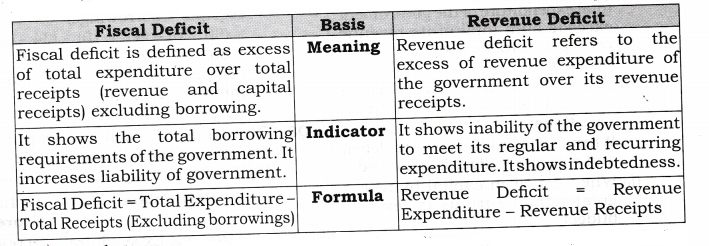
Question 3. Difference between primary deficit and fiscal deficit. [Delhi 2013] [3 Marks]
Answer: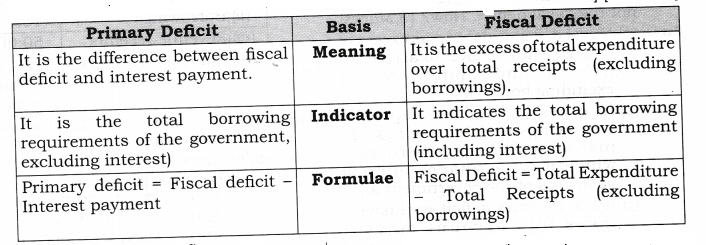
Question 4. How can a deficit be financed? [3 Marks]
Answer: A deficit can be financed in two ways:
- Monetary Expansion: It means printing new notes to the extent of deficit. It involves government borrowings from the Central bank (Reserve Bank of India) through the issue of the treasury bills to the Central Bank. The Central Bank purchases the treasury bills in return for cash (procured by printing new notes). The government use this cash to finance the deficit.
- The second method of financing the deficit is borrowing by the government from the public through market loans etc.
- By borrowing from abroad (rest of the world).
Question 5. Can there be a fiscal deficit in a government budget without a revenue deficit? Explain. [CBSE Sample Paper 2008] [3-4 Marks]
Answer:
- Yes, there can be a fiscal deficit in government budget without any revenue deficit.
- Revenue deficit is a position where total revenue expenditure of the government exceeds its total revenue receipts.
- Fiscal deficit is a position where total expenditure of the government exceeds sum total of its revenue receipts and non-debt capital receipts.
- Hence, there can be a fiscal deficit without revenue deficit in following situations:
(i) When capital budget shows a deficit and revenue budget is balanced.
(ii) When deficit in capital budget is greater than surplus in revenue budget.
Question 6. Revenue deficit is the real deficit and not the fiscal deficit. How? [3 Marks]
Answer:
- Fiscal deficit is defined as excess of total expenditure over total receipts (revenue and capital receipts) excluding borrowing.
- In other words, it is equal to borrowings and borrowings are just an act of the government which may be finance interest payments of the government also.
- While revenue deficit exclusively takes into account current interest payment obligations of the government not connected with the actual activities.
- Thus, revenue deficit is more important than fiscal deficit.
Question 7. From the following data about a government budget find: (a) revenue deficit, (b) fiscal deficit and (c) primary deficit: [CBSE, All India 2011] [3 Marks]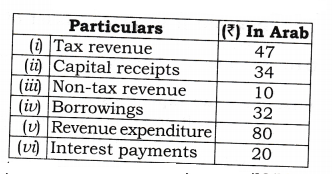
Answer: (a) Revenue deficit = Revenue expenditure – Revenue receipts (Tax revenue + Non-tax Revenue)
= 80 – (47+10) = Rs. 23 Arab
(b) Fiscal deficit = Total expenditure (Revenue expenditure + Capital expenditure) – Revenue receipts(Tax revenue + Non-tax revenue) – Non-debt Capital ReceiptfCapital receipts – borrowings)
= (80 + 0) – (47 + 10) – (34 – 32)
= 80 – 57 – 2 = Rs. 21 Arab
(c) Primary deficit = Fiscal deficit – Interest payments
= 21 – 20 = Rs. 1 Arab
8. Find (a) fiscal deficit and (b) primary deficit from the following items: [CBSE Sample Paper 2013] [3 Marks]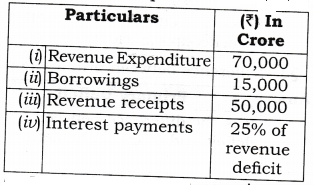
Answer: (a) Fiscal deficit = Borrowings = Rs. 15000 crore.
(b) Primary deficit = Fiscal deficit – Interest payments = 15000 – 25% of (70000 – 50000) = 15000 – 25% of 20000 = 15000 – 5000 = Rs. 10000 crore.
VII. Value Based Questions
Question 1. There has been consistent rise in prices of fruits and vegetables in Delhi for sometimes. Which measures of budget will you support to reduce the prices of these commodities? [ 1 Mark]
Answer: Prices of fruits and vegetables can be reduced by providing subsidies to the producer of fruits & Vegetables and the government should also provide fruits and vegetables at subsidised rates to the consumers through public distribution system.
Value : Problem solving
Question 2. Budget deficit creates disequilibrium in every economy, but in developing countries like India, why does government depend on it? [ 1 Mark]
Answer: Per capital income in developing countries like India is comparatively low so the tax receipts of the government are not sufficient, but on the other hand government has to incur heavy public expenditure for the development of economy so a government is compelled on budget deficit.
Value : Economic awareness
Question 3. In India a majority of population is lying below poverty line due to inequality of ‘Income and Wealth’. How can budget be helpful in solving this problem? [1 Mark]
Answer: In Indian budget progressive tax system can be a good measure to remove the inequality of ‘income and wealth’ and government should provide social facilities like education, health and food grain to the poor at subsidized rates.
Value : Problem solving.
Question 4. Classify the following items into revenue expenditure and capital expenditure. Give reason for your answer. [3-4 Marks]
(a) Free supply of stationary to the students by the government.
(b) Economic assistance given according to Ladli scheme.
(c) Expenditure on the construction of computer lab in school by the government.
(d) Expenditure on Mid Day Meal given to students by the government.
Answer: (a), (b) and (d) are revenue expenditures because they neither create assets nor cause reduction in assets.
(c) is capital expenditure because it increases assets of the government. Value : Analytic
Question 5. In India, for the last several years, there has been deficit in the revenue account. How is it met or financed? [1 Mark]
Answer: Two measures to reduce revenue : deficit:
- Government should reduce revenue expenditure.
- To increase taxes, both direct and ; indirect.
Value : Analytic
Question 6. If you were to be appointed as the Finance Minister of India, which taxes would you prefer: direct taxes or indirect taxes and why? [3-4 Marks]
Answer: As we know, direct tax and indirect tax are complimentary to each other i.e., they are not substitutes to each other. There is really nothing to choose between direct taxes and indirect taxes as such. Both of them have their relative merits and demerits.
They differ from each other as:
- Indirect taxes reach all the sections of the society; whereas direct taxes cannot reach all the sections.
- Direct taxes can be highly progressive; whereas Indirect taxes are generally proportional.
- Indirect taxes can be easily used to influence the consumption of specific commodities; whereas direct taxes cannot be used thus. In short, it is necessary to strike a balance between direct taxes and indirect taxes as a source of tax revenue.
Question 7. Should we rely exclusively on direct taxes for mobilizing tax revenue because indirect taxes are inequitable? Comment. [3 Marks]
Answer:
- We cannot depend solely on direct taxes because they are progressive in nature and there is possibility of tax evasion.
- But as against it indirect taxes are proportional in nature and are generally imposed on commodities (necessity goods etc.) which each and every individual purchase.
- So, direct and indirect tax are important for providing funds for investment and for other social welfare considerations.
Question 8. Levy of taxes on all commodities without caring for their impact on the common man is not desirable. Comment. [3 Marks]
Answer:
- Indirect taxes such as sales tax and excise duty fall heavily on the shoulders of a common man.
- This means they are inequitable.
- Therefore, in such a situation, tax basket should be a mixture of direct and indirect taxes both.
Question 9. It is not only difficult but impossible to tax all those who should be taxed, in India. Why? [ 1 Mark]
Answer: Due to lack of necessary information and disclosures required, tendency of the people to avoid taxes and lack of efficient implementation machinery, it is not possible to tax all those who should be taxed.
Question 10. In the government of India budget for the year 2013-14 the Finance Minister proposed to raise the excise duty on cigarettes. He also proposed to increase income tax on individuals earning more than ? One crore per annum.
Identify and explain the types of taxes proposed by the finance minister. Was the government’s objective only to earn revenue themselves? What possible welfare objective could the government be considering? Explain. [6 Marks] [CBSE Sample Paper 2014]
Answer: (a) Excise Duty: Indirect Tax When (a) liability to pay a tax (Impact of tax) is on one person; and(b) the burden of that tax (Incidence of tax), falls on the other person, it is termed as indirect tax.(b) Income Tax: Direct Tax When (a) liability to pay a tax (Impact of Tax), and (b) the burden of that tax (Incidence of tax), falls on the same person, it is termed as direct tax.(c) Besides the objective of raising more revenue, the proposals also serve some welfare objectives.
- First, raising excise duty on cigarettes makes cigarettes costlier and discourages smoking. Less smoking have positive influence on health and raises welfare of the people,
- Secondly, raising income tax on incomes above ? one crore will help in reducing inequalities in income.
- Thirdly, the extra revenue is raised from these proposals, and if spent on health and education of the poor it will do the welfare of the poor.
Question 11. Regulation of prices in the case of agricultural products is not only desirable but necessary. Explain. [3 Marks]
Answer:
- As we know that agricultural production depends upon natural factors like rainfall, climate etc. these natural factors creates a situation of drought or surplus production.
- Therefore, in such a situation for helping farmers in case of drought the government should fix a price lower than the market price (which is also known as price ceiling) and in case of the surplus production the government should fix a price higher than the market price (which is also known as price floor).
- Surplus or shortages should be met by the government from its buffer stock operations through Public Distribution System (PDS) such as ration shops or fair price shops.
Question 12. We should try to regulate interest rates prevailing among farmers, weaker sections of society and poor villagers. How can we control it? [3-4 Marks]
Answer:
- A government and monetary authorities fix the rate of interest which is based on bank rate fixed by the RBI and consequent interest rates are charged by the commercial banks.
- In this regard we have regional rural banks being set up in rural areas to benefit the rural artisans, small and marginal labourers and weaker sections of the society.
- They provide credit assistance at concessional lending rates.
- However, weaker sections of society including poor farmers and villagers pay very high rate of interest which they pay to the moneylenders or zamindars.
- Therefore, for reducing rate of interest for such people, some necessary steps should be taken such as promoting cooperative societies etc.



0 Comments
Please Comment